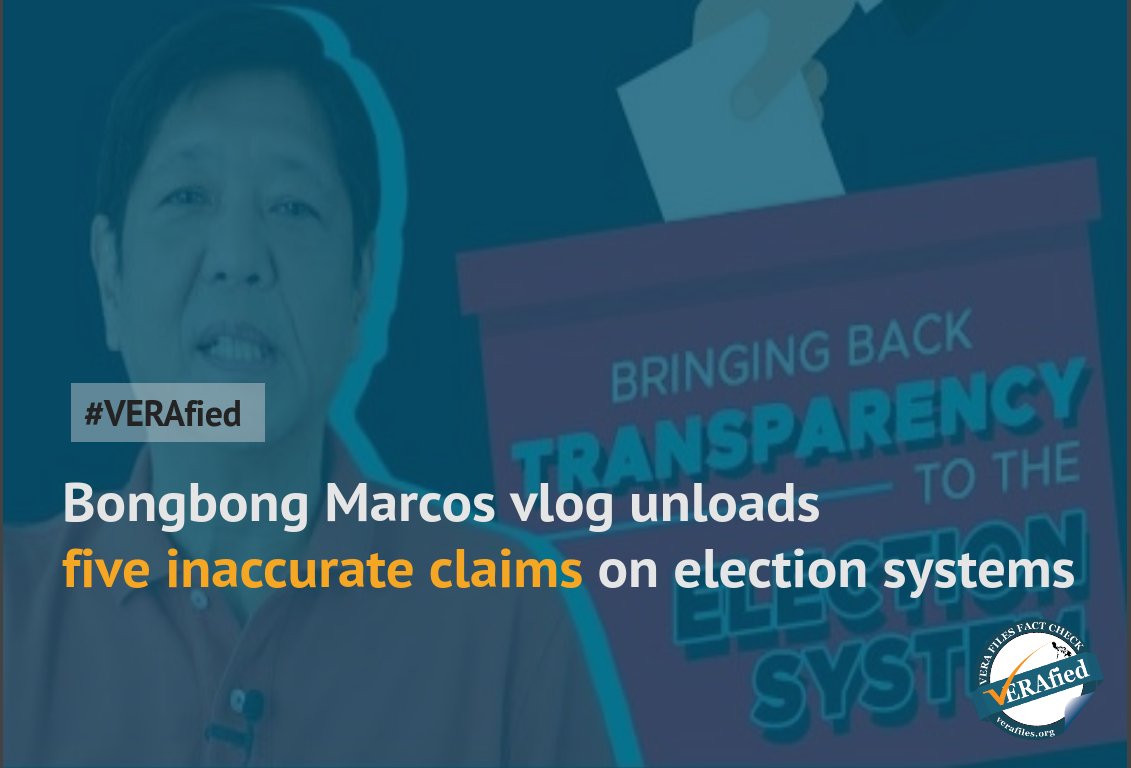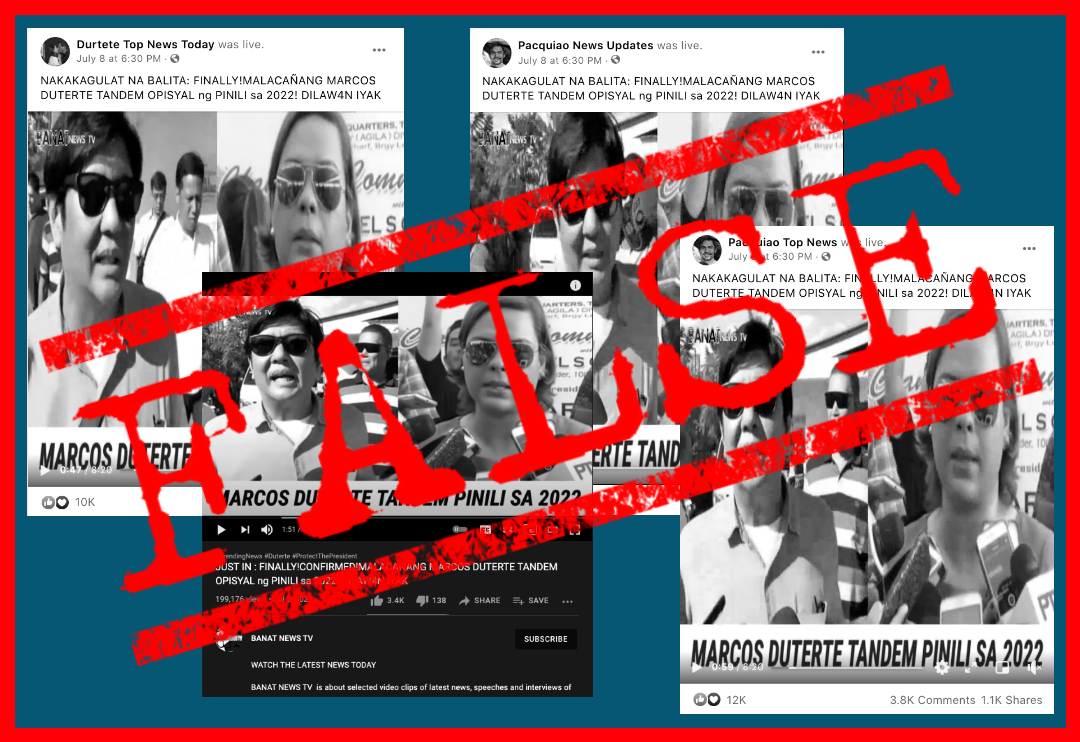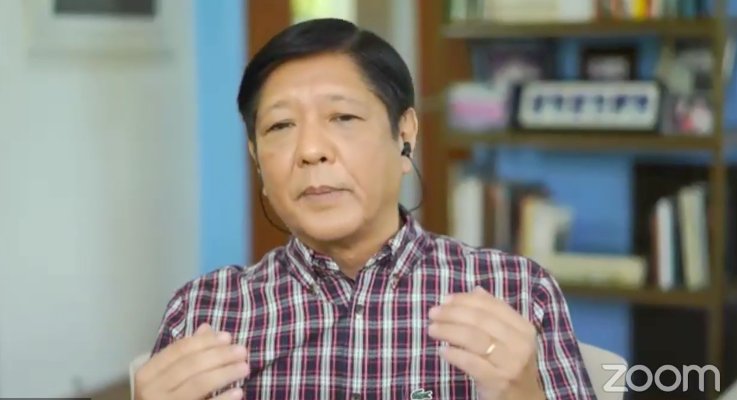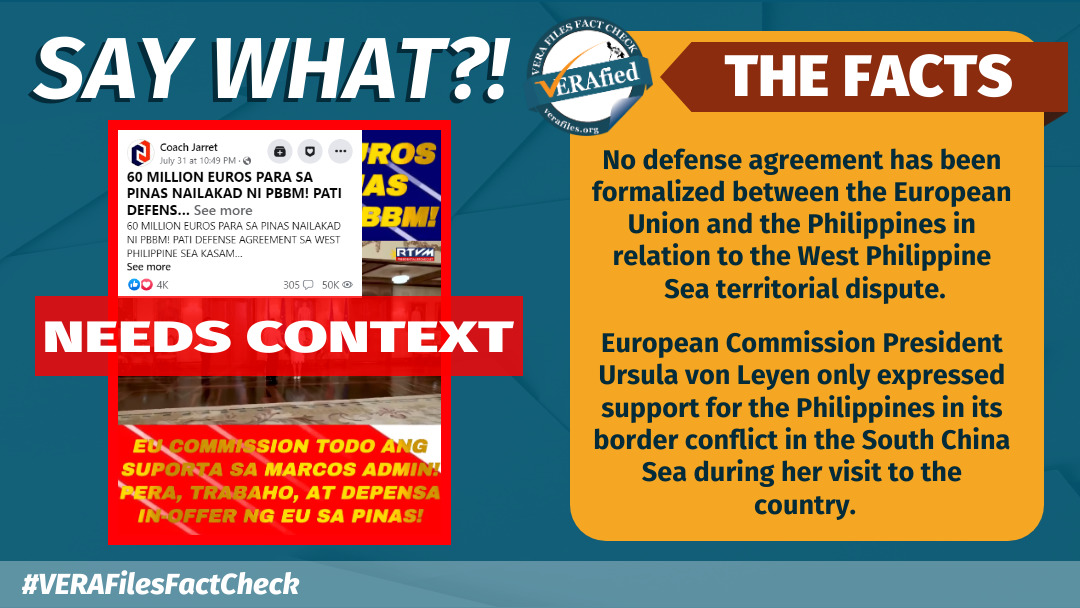A two-month-old vlog by former senator Ferdinand “Bongbong” Marcos Jr. that bears false and misleading claims about the Philippines’ electoral system continues to circulate on social media.
It was posted Feb. 20 on his Facebook (FB) and YouTube accounts after the Supreme Court (SC) — sitting as the Presidential Electoral Tribunal (PET) — unanimously dismissed his poll protest against Vice President Leni Robredo. The six-minute video revolved around Marcos’ allegation that the automated election system leads to cheating and fraud, and presented a “hybrid election system” as an alternative.
The clip began with the erroneous claim of Marcos’ lawyer Vic Rodriguez that the PET dismissed only the former lawmaker’s second cause of action for a recount in select pilot provinces, and not his third cause of action to annul votes in three provinces in Mindanao due to alleged fraud.
An updated SC briefer on Feb. 16 noted that the tribunal had dismissed Marcos’ “entire electoral protest.” This was again confirmed by the full SC decision, released on April 19, which stated: “All told, the third cause of action fails and is likewise dismissed.” (See VERA FILES FACT SHEET: Understanding the PET’s junking of Marcos’ poll protest vs. Robredo)
VERA Files Fact Check looked into Marcos’ claims in his Feb. 20 vlog and identified one that was false, three misleading, and another that needed context.
Read on to know more about each claim:
On the speed of manual counting
Latest data show that the number of voters per precinct can range from 200 to 1,000, according to Commission on Elections (Comelec) Spokesperson James Jimenez. He added that the manual counting of votes from 600 to 800 voters in a matter of hours has been “proven [false] time and again by COMELEC studies.”
In a Viber message to VERA Files Fact Check, Jimenez, also the director of the Comelec Education and Information Department, said “even under clinical conditions, it has taken hours just to complete a count of far fewer ballots.”
Historical records from election watchdog National Movement for Free Elections (NAMFREL) show that manual tallying and counting of votes in a precinct with 200 to 250 voters could take five to 24 hours, according to National Council Member Angel Averia.
On countries that use ‘manual voting’
Marcos said this as a preface to his claim that many countries have stopped “electronic voting.” The accompanying graphic in his video did not use his wording and instead read: “209 out of 227 countries still use paper ballots.”
This is misleading. Using paper ballots does not necessarily mean a country is not automating any part of the voting process.
A cursory search led VERA Files Fact Check to an Oct. 30, 2020 article by United States-based think tank Pew Research Center, which reflected Marcos’ figure: that 209 of 227 countries tracked by the ACE Electoral Knowledge Network use paper ballots.
This includes the Philippines, where paper ballots are manually marked during polls. What is automated in the country’s 2016, 2019, and the upcoming 2022 elections are the counting, canvassing, and transmission of votes.
Two of the three countries that Marcos cited as having “stopped” electronic voting — Finland and Ireland — had tried a type of voting that was fully electronic, beginning with the choosing of candidates done through a machine.
On countries returning to manual voting
Marcos quoted a 2018 article about the case of Finland, where a working group appointed by its Ministry of Justice concluded in a 2017 feasibility study that “online voting should not be introduced in general elections as its risks are greater than its benefits.”
Encyclopedia Britannica defines online voting as a system in which votes can be cast through the Internet without going to an election precinct or manually filling out ballots.
It is different from electronic voting, in which choosing candidates is done through the aid of a computer.
The Philippines does not employ online voting. Neither does it do electronic voting in the strictest sense. It uses an automated election system that uses paper ballots to record votes, and then tabulates, canvasses, and transmits the results of vote counting electronically.
On the percentage of votes counted in 2013
While only 76% of total votes were transmitted in the Comelec’s transparency server during the May 2013 national and local elections, as reported by the media, this was “not the basis for the official count,” according to Jimenez.
The transparency server merely mirrors the data received by the Comelec in its central server — the “central repository of all election results” — from the vote counting machines and board of canvassers in real time. (VERA FILES FACT SHEET: 3 things you should know about Comelec’s transparency server – Vera Files)
In case of failed electronic transmission, Jimenez said vote results “can still be physically delivered via storage media to the next canvassing level” in accordance with the Comelec’s contingency plans.
Jimenez also told a joint congressional hearing in June 2019 that 1,051 or 1.22% of 85,769 vote counting machines (VCMs) that malfunctioned were replaced, while 2,246 defective SD cards, or 1.31% of those actually used, were reconfigured during the 2019 midterm elections. In a press conference on May 14, 2019, a day after the elections, Comelec said 1,253 out of 1,665 defective SD cards were replaced.
VERA Files Fact Check’s request for official data from Comelec on the transmission rate of votes to the central server, total votes consolidated and canvassed, and the number of storage media physically delivered to the canvassers during the 2013 national elections, remains pending. The same goes for the total number of defective SD cards and VCMs which had to be replaced or repaired during the 2019 elections.
On the youth’s voter pessimism
While the headline flashed in the vlog presents Filipino youth losing faith in the election, the actual 2019 Deutsche Welle story featured sentiments from only two Filipino students.
The students said they lost their faith in the political system because “candidates backed by the administration always win,” and because the people who won in the election were “likely to protect the interests of President Rodrigo Duterte.”
Neither the Social Weather Stations nor Pulse Asia, which are independent polling bodies in the country, have conducted official surveys on the topic.
To support Marcos’ opinion, the video also misled viewers by flashing an informal February 2021 poll by website PH Pulse (phpulse.com) that asked netizens why they have not yet registered to vote in the next national elections in 2022.
While 375 of 626 respondents (59.9%) answered “walang tiwala sa sistema (no trust in the system),” it does not elaborate any further. The non-disclosure of the poll’s demographic makes it impossible to see the breakdown of responses by age.
Sources
Bongbong Marcos official YouTube channel, BBM VLOG #148: Bringing Back Transparency to the Election System | Bongbong Marcos, Feb. 20, 2021
Senate of the Philippines, My election protest will be a precedent setting case — Bongbong Marcos, June 29, 2016
Bongbong Marcos official Twitter account, Statement of Atty. Vic Rodriguez, spokesperson of former Senator Ferdinand Marcos Jr., Feb. 16, 2021
Supreme Court of the Philippines, UPDATED PRESS BRIEFER on PET CASE No. 005, Feb. 16, 2021
Supreme Court of the Philippines, Ferdinand “Bongbong” R. Marcos, Jr. Vs. Maria Leonor “Leni Daang Matuwid” G. Robredo (P.E.T. Case No. 005), Accessed April 19, 2021
On Claim 1 (speed of manual counting)
- Parish Pastoral Council for Responsible Voting, PPCRV 2019 Report.pdf, 2019
- Personal communication with COMELEC Spokesperson James Jimenez, March 10, 2021
- Personal communication with NAMFREL National Council Member Angel Averia, March 13, 2021
- James Jimenez, LinkedIn profile, Accessed April 20, 2021
On claim 2 (countries with manual voting)
- Pew Research, From voter registration to mail-in ballots, how do countries around the world run their elections?, Oct. 30, 2020
- ACE Project, Philippines
- Comelec, 2016 elections, Aug. 22, 2015
- Comelec, 2019 National and Local Elections, Sept. 19, 2018
- Comelec, 2022 National and Local Elections, Feb. 9, 2021
On Claim 3 (countries returning to manual voting)
- Ministry of Justice, Finland, Working group: Risks of online voting outweigh its benefits, Dec. 19, 2017
- Ministry of Justice, Finland, Summary of the feasibility study, Dec. 19, 2017
- Encyclopedia Britannica, I-Voting, Oct. 7, 2008
- Medium.com, What is Online Voting?, March 18, 2020
- Encyclopedia Britannica, Electronic Voting, Oct. 7, 2008
- Official Gazette, Republic Act No. 9369
- The Voting News, Finland: Security fears delay roll-out of national e-voting system in Finland | Computer Weekly, March 2, 2018
On Claim 4 (percentage of counted 2013 counted votes)
- Rappler.com, Comelec to stop ‘transparency’ count, May 16, 2013
- Balita, Comelec chief: 2016 polls, pinakaorganisado, May 21, 2016
- Inquirer.net, PPCRV suspends unofficial tally upon Comelec’s orders, May 16, 2013
- Senate of the Philippines, Joint Congressional Oversight Committee on the Automated Election System (June 04, 2019), June 4, 2019
- Senate of the Philippines, Sen. Kiko to Comelec: What happened in 7-hour glitch?, June 4, 2019
- ABS-CBN News YouTube channel, Comelec press briefing | 14 May 2019
- VERA Files, Amid glitches, PPCRV to make proper assessment of 2019 polls, May 15, 2019
- Inquirer.net, 961 VCMs, 1,665 SD cards suffer glitches in 2019 polls — Comelec, May 14, 2019
- Rappler.com, Comelec says 961 vote-counting machines defective, May 14, 2019
On Claim 5 (youth’s voter pessimism)
- Deutsche Welle, Philippine youth losing faith in the election, May 21, 2019
- PH Pulse, BAKIT HINDI KA PA NAGPAPAREHISTRO
(Guided by the code of principles of the International Fact-Checking Network at Poynter, VERA Files tracks the false claims, flip-flops, misleading statements of public officials and figures, and debunks them with factual evidence. Find out more about this initiative and our methodology.)





